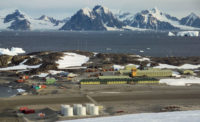
Building the British Antarctic Survey's newly commissioned research station in one of the remotest, coldest spots on earth was every bit as tough as it sounds.
A short, nine-week construction season, bitter weather and tortuous supply lines were always on the daily management agenda. An unwelcome surprise arrived when cracks appeared in the first module of the Halley Vl station as it reached Antarctica's frozen wilderness.
The research station's modules look like a train, with eight glass-reinforced fiber (GRP) modules now strung in a line across the Brunt Ice Shelf, which flows about 400 meters a year toward the sea, periodically breaking off into icebergs.
Temperatures fall to -56 degrees C, and everything in the station gets buried in 1.5 m of snow annually. For the next 20 years at least, the 1,510-sq-m Halley Vl will be home to up to 52 scientists working in this frozen world.
Hydraulic legs on skis hold the eight accommodation-and-work modules above the snow. Each summer, the legs will raise the modules out of the winter's snow. When the moving ice takes the station too close to the sea, tractors will tow the modules to a safer location.
"We did a tremendous amount of work developing the ski system," says Peter Ayres, project director at AECOM Ltd., London. AECOM teamed with London-based Hugh Broughton Architects to secure the design contract for the sixth Halley station since 1957.
Halley stations have evolved from wooden sheds to underground and stilted structures, says Karl Tuplin, British Antarctic Survey's (BAS) senior project manager. For the sixth-generation version, the brief included the ability to relocate.
BAS sign up its designers in a competition in 2006 and hired Galliford Try Ltd., Matlock, to help the three short-listed teams develop their schemes.
Tuplin would have liked a different contractor on each team, but Galliford was the only qualified firm to show interest, he says.
Having previously recruited managers who had worked for BAS, the contractor had the right Antarctic expertise, explains its contract manager on the Halley job, Peter Willmott.



Post a comment to this article
Report Abusive Comment